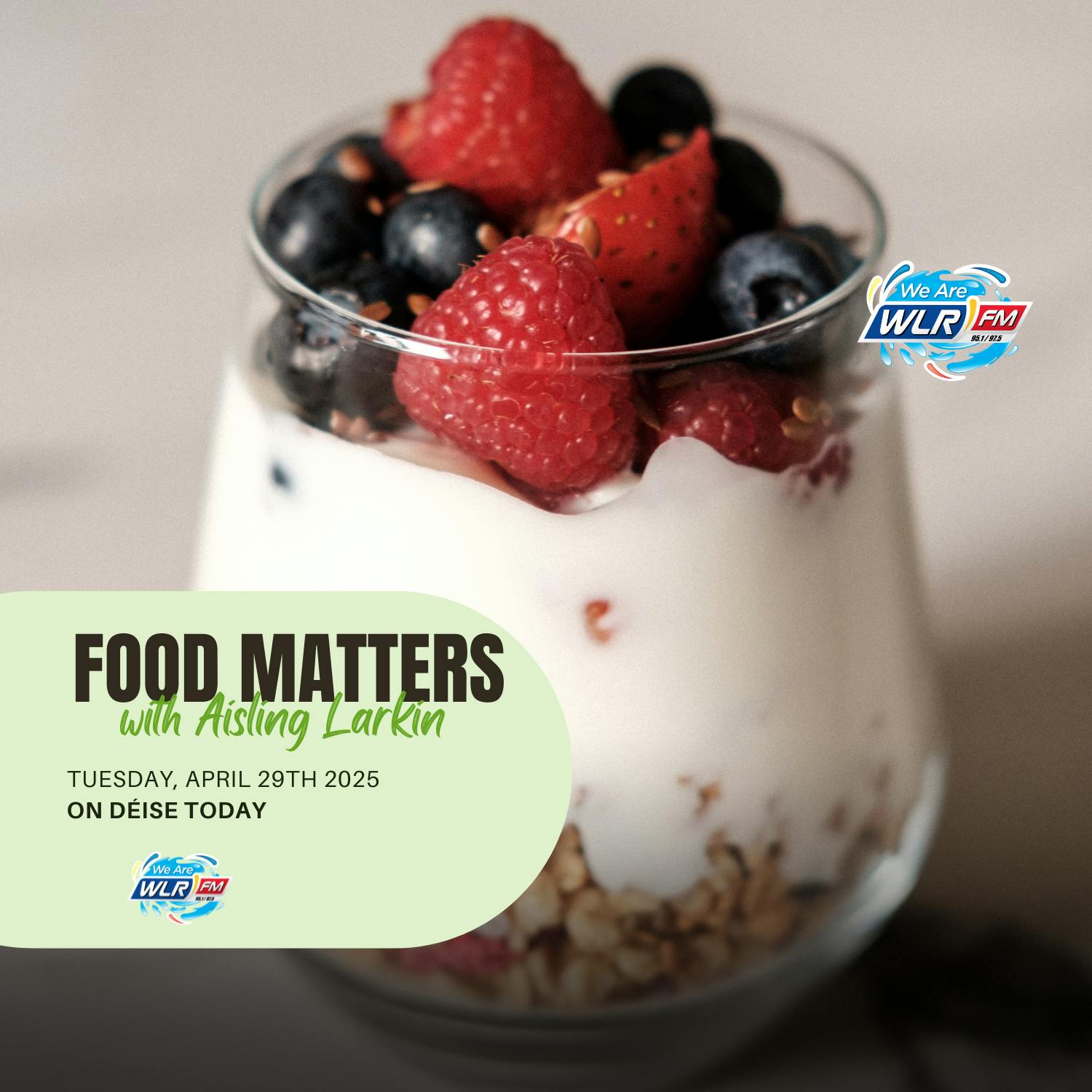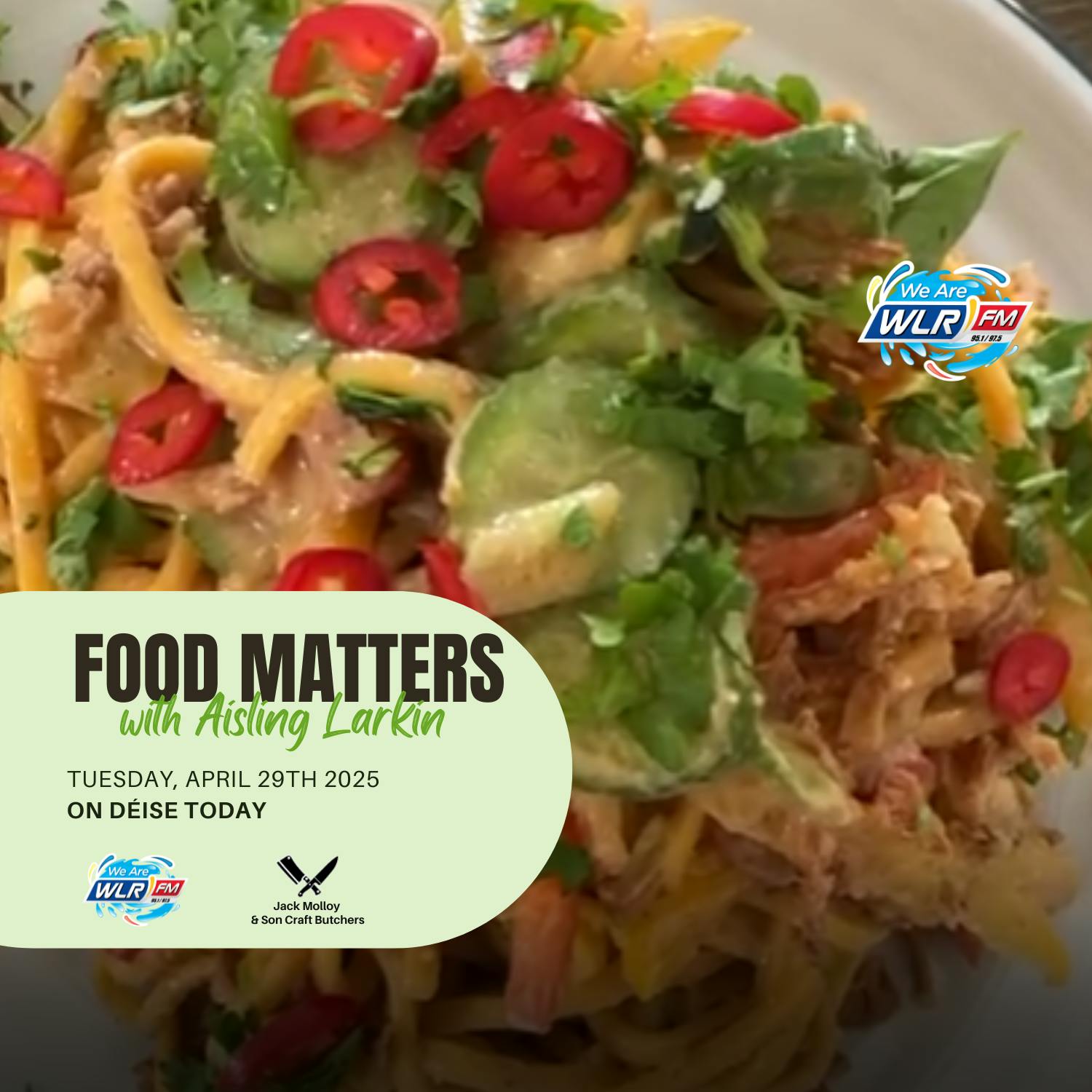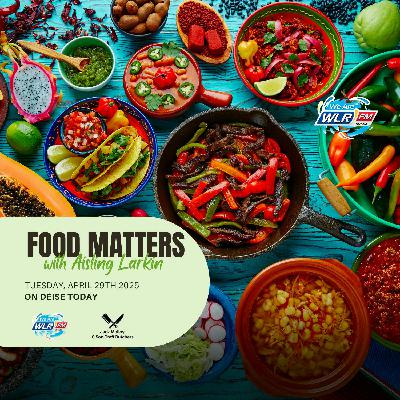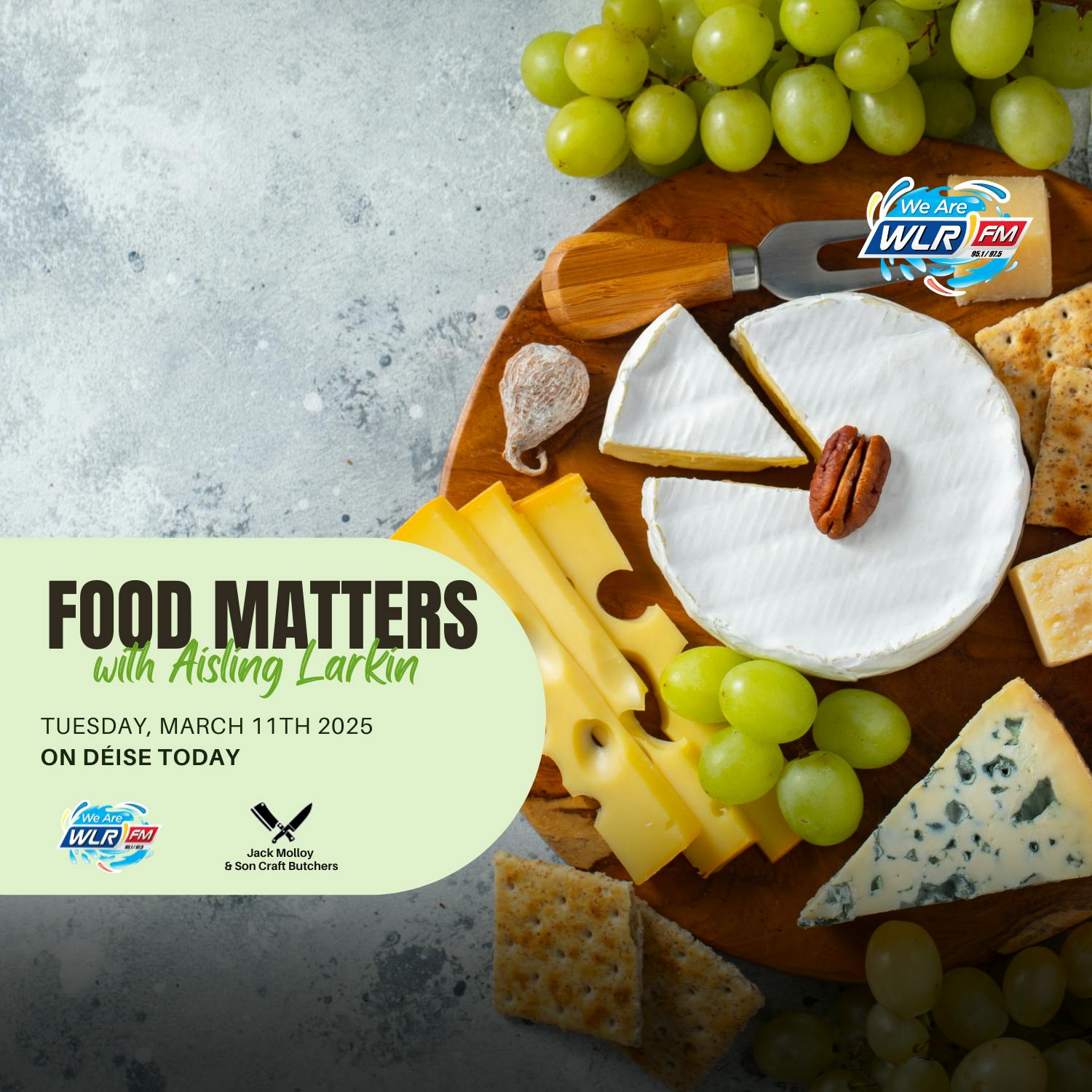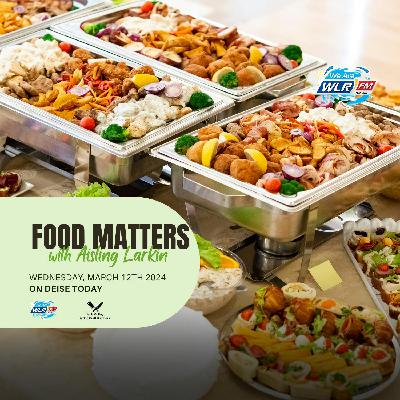Discover Food Matters with Aisling Larkin
Food Matters with Aisling Larkin

Food Matters with Aisling Larkin
Author: WLR
Subscribed: 1Played: 2Subscribe
Share
© WLR
Description
Déise Today has proudly teamed up with well-renowned Chef, TV Cook, and Food Media Broadcaster Aisling Larkin. Together, we present a bi-weekly Wednesday feature, where Aisling expertly explores the realm of home cooking. From elevating everyday family recipes to innovative ways to utilise leftovers, join us on Food Matters as Aisling shares her culinary insights and inspirations.
34 Episodes
Reverse
In Episode 34 of Food Matters, well-renowned Chef, TV Cook, and Food Media Broadcaster Aisling Larkin talks about Yoghurt - It’s More Than a SnackIreland’s Love Affair with a Cultured ClassicToday, we’re diving into the creamy, tangy, and endlessly versatile world of yoghurt — a fridge staple in homes across the country.From the rise of the Irish yoghurt market to the many varieties available, Aisling explores the nutritional benefits and takes us on a journey through yoghurts from around the world.
In Episode 33 of Food Matters, well-renowned Chef, TV Cook, and Food Media Broadcaster Aisling Larkin gives us some great recipes for Summer Salads
In Episode 32 of Food Matters, well-renowned Chef, TV Cook, and Food Media Broadcaster Aisling Larkin explains why Mexican food can be a great way to get us to eat 30 plants per week.Food Matters is brought to you thanks to Jack Molloy & Son Craft Butchers, Barrack Street, Waterford. Spices Garlic Powder - backbone savoury mellow noteOnion Powder - savoury undertoneCumin - strong, warm, earthy, toasty flavour. Cumin is traditionally Mediterranean and a lot will say has no origins in Mexican cookery, but it is essential for that Tex-Mex style of cookingSmoked PaprikaOregano - again even though considered a quintessential Italian herb, it adds an earth freshness to a dish. Mexican oregano is different, and we tend to use it dried a lot. Mexican oregano is a cousin of lemon verbena, with lingering citrus liquorice notes and a little bit grassy. Mexican oregano is not as strong. Dried oregano is very popular.Coriander - seeds - dried powder - much less harsh than fresh coriander. Its brings an earth-floral warmth to dishesChilli - ancho, chipotle, dried, smoked, jalapeno - ancho rich dried fruit flavour, whereas chipotle big, robust is better for salsa and sauce. Other hints of spices that will work wellCinnamonNutmegCacaoSesame HerbsRosemarySageMint Popular Mexican SaucesPico de Gallo Pico de Gallo is a fresh chopped mixed of red tomato, fresh shallot, jalapeño, lime and coriander. Pico is always a salsa fresco, a fresh salsa with chopped ingredients. It should be made fresh and serves fresh.Salsa is a cooked version of this with more of a tomato base or it can be a more blended version. Guacamole / avocado cremaAvocado, lime juice, coriander, red onion, tomatoAdd sour cream or mayo Salsa Verde / ChimmichurriVerde means green. A classic Mexican salsa verde is not like we know it. It is made from tomatillos. Tomatillos look like small green tomatoes with husks but they are not tomatoes, they are cousins. They are borderline sour, so roasting them is a great idea.Then the salsa is just a combination of roasted tomatillos, chilli peppers, garlic, onion, and coriander. The Italian salsa verde is a combination of capers, cornichons, anchovy, mustard, garlic, big bunches of fresh, soft bright green herbs and then red wine vinegar, salt and olive oil.Sometimes bug chunks of bread are soaked in the vinegar first and then blended in. MoleMole poblano is a dark, reddish-brown sauce made from a combination of ingredients such as dried chili peppers (like ancho, pasilla, and mulato), nuts (such as almonds, peanuts, or sesame seeds), chocolate, spices, fruits (like plantains or raisins), and sometimes even a small amount of bread or crackers to thicken the sauce. The exact ingredients and proportions can vary widely depending on the recipe and the cook's preferences.Making mole poblano from scratch can be quite involved, as it often requires toasting and grinding various ingredients before simmering them together to develop complex flavors. Here's a basic outline of the process:1. Prepare the chilies: Remove the stems and seeds from the dried chili peppers, then toast them in a dry skillet until fragrant. Be careful not to burn them. Once toasted, rehydrate the chilies by soaking them in hot water until softened.2. Toast other ingredients: Toast nuts, seeds, and spices in a dry skillet until fragrant. Again, be careful not to burn them.3. Blend ingredients: Drain the soaked chilies and combine them in a blender or food processor with the toasted nuts, seeds, spices, chocolate, and any other ingredients specified in your chosen recipe. Blend until smooth, adding a bit of chicken or vegetable broth as needed to achieve the desired consistency.4. Cook the sauce: Heat a bit of oil in a large pot or skillet and pour in the blended mixture. Cook over medium heat, stirring constantly, for several minutes to allow the flavors to meld and the sauce to thicken slightly.5. Simmer: Once the sauce is cooked, add more broth to reach your desired consistency, and then simmer the sauce over low heat for at least 30 minutes to an hour, stirring occasionally.6. Adjust seasoning: Taste the mole and adjust the seasoning as needed, adding more salt, sugar, or spices to balance the flavors to your liking.7. Serve: Mole poblano is often served over cooked chicken or turkey, but it can also be served with pork, beef, or vegetables. Traditionally, it's accompanied by rice and warm corn tortillas. While making mole from scratch can be time-consuming, the result is a rich, flavorful sauce that's sure to impress. If you're short on time, you can also find pre-made mole paste or sauce in many grocery stores, which can be a convenient alternative. MeatSlow Cooked Pulled PorkCarnitas - Carnitas are Mexico’s version of pulled pork. Made by slow-cooking pork fully submerged in lard, this confit method of cooking yields pork that’s unbelievably rich and tender with loads of crispy golden bits. Unfortunately, most of us home cooks don’t have huge vats of lard just sitting around. So luckily there is a way to make very similar carnitas I a slow cooker or a pressure cooker..Use a dry spice rub mic of oregano, cumin, smoked paprika, onion powder and garlic powder, salt and pepper.Dry until caramelised around the edges.Put it in the slow cooker and top with onions, garlic, jalapeños and orange juice. Cook it low and slow for 10 hours. Until it is pulled part tender and infused with incredible flavour.Pan-fry the meat, tossing it in some of the cooking juices.Optional then to grill for crispy bits.serves drizzled in more juices. Remove the skin but leave the fat Uses of this meatTacos, burritos, quesadillas, enchiladas, sliders, Mexican rice, taco soup. It will keep for 3 days in the fridge. Elote - corns on the cobGrilled corn on the cob, spread with butter, slathered in a thin layer of mayo topped with a sprinkle of chilli powder, cheese ( parmesan, cheddar ). Garnished with lime and coriander. Eat immediately. Refried Beans1 tin mixed beans - pinto, kidney, chickpeas, butterbeanOilClassic 5 - onion and garlic powder, smoked paprika, cumin and oregano, salt and pepper.Tin of beansDrop of water or stockBlitz, stir in some sour creamServe Churros and Chocolate sauce Chocolate sauce 250ml water100g sugar160g glucose / golden syrup75g cocoa powder55g dark chocolate Method • In a medium saucepan, whisk together the water, sugar, glucose and cocoa powder.• Warm the mixture over medium heat, whisking frequently. Once it just begins to boil, remove from heat and stir in the chopped chocolate until melted.
In Episode 31 of Food Matters well-renowned Chef, TV Cook, and Food Media Broadcaster Aisling Larkin will give us examples of some recipes for Lamb dishesFood Matters is brought to you thanks to Jack Molloy & Son Craft Butchers, Barrack Street, Waterford. Recipes to DiscussLamb Massaman Curry Creamy Tomato Lamb Ragu PastaLamb Flatbreads with Creamy Yogurt Seasonality and Religious Tradition • The tradition of eating lamb at Easter comes from Judaism. For the Jews, Easter was a feast to celebrate the freedom from slavery. • The Jewish tradition of eating lamb recalled the lamb blood used to mark the doorjambs of Jewish families that were prisoners in Egypt, and which protected the firstborns from the coming of the ‘exterminator lamb’.• The Jewish Festival of Passover is traditionally a spring festival – and this is when the Passover Lamb is killed.• For Christians, the lamb is more a representation of Jesus sacrificing himself and dying on the cross – Jesus being “the lamb of God”. It’s most likely that Christians eat lamb at Easter to remember this sacrifice.• The association of Jesus as "the lamb of God" also may have helped tie the consumption of this meat to Easter. Furthermore, lamb's availability as an accessible meat after winter months with no livestock to slaughter would also encourage our ancestors to serve up a few lamb legs to celebrate. Nutritional ValueVery similar to beefWhat we want to be watching out for - from an over-analysed perspective that is regardless to most - grass fed lamb v grain-fed lamb.• Similar protein as beef and fat content• The iron is haem iron - haem and non haem - haem great to circulate blood around the body.• Full of B vitamins, 100g of lamb can provide around three quarters of your daily requirements. These clever vitamins (B12, niacin, pyridoxine, riboflavin and panthothenic acid) are like a superhero squad which help your body run smoothly. Some B vitamins help with energy levels and some help with skin, brain, blood and eye health, so there’s something for nearly every body department• It's high in zinc Zinc, a nutrient found throughout your body, helps your immune system and metabolism function. Zinc is also important to wound healing and your sense of taste and smell. Fatty / Gamey Flavour Lamb comes from sheep under 14 months old, while meat from older animals is called mutton. The younger the lamb, the more tender the meat. • Why? The tenderness of cooked lamb is directly related to the number of chemical cross-links holding the collagen proteins together. • The number of cross-links increases with the age of the animal, and as the number increases, the process of breaking down the collagen to soluble gelatin becomes more difficult, requiring longer cooking times or higher temperature.• Lamb's unique flavour comes, for the most part, from its fat. • Beef and lamb each contain both saturated and unsaturated fatty acids. But lamb also has smaller, branched-chain fatty acids, produced by bacteria in their rumen. • These medium-length branched-chain fatty acids make up a small percentage of the total fat, but because they are fairly volatile and have a very low odour threshold, humans can detect them at low concentrations. They give lamb its particular "gamy" flavour.This is in part because lamb has a strong and distinctive flavour. It's a flavour that comes mainly from its fat—in particular, branched-chain fatty acids (BCFAs) produced by bacteria in the lamb's rumen. (Research published in the journal Meat Science in 1997 proved that these BCFAs, which are found in a far higher concentration in lamb meat than any other meat, are responsible for this characteristic “gamy” flavuor.)The concentration and resulting pungency of these BCFAs depend in part on the breed of lamb, but mainly on the lambs' diet. Lambs raised on a diet of grass tend to have a more intense flavour than those raised on a diet of grain. The grassy, gamy flavors, known as “pastoral flavors,” that occur in pasture-finished lamb come from an increased amount of compounds called indoles, primarily one called skatole, found in the fat tissues. The amount of BCFAs and indoles increases with age. This flavour change is largely due to chemistry: pasture-fed on mixed grasses is different to lamb who begins their diet of grass but finishes with grain. The switch to grain has a direct impact on the composition of the animal's fat, reducing the concentration of the BCFAs, and ultimately leading to sweeter-tasting meat.n addition to choosing lamb that's grass-fed or grain-fed, you can control how gamy or mild lamb tastes by choosing the right cut. Cuts from the shank, shoulder (including roasts, chops, and stew meat), and leg (bone-in or boneless leg of lamb) have more fat and thus a more intensely lamby flavour, while cuts like rack of lamb, rib chops, and loin chops have less fat and taste sweeter. COOKING LAMBRoast Lamb or Braise LambAromatics - bay, onion, garlicStock and wineSearStudCover with foilLow and slow - 140oC.RestReduce to make a jus / gravy WHY ITS OK TO EAT PINK LAMB When it comes to gamey perfection, don’t overcook the meat. Instead, think pink • For a time there was a fashion among the supposedly sophisticated to go to the opposite extreme and serve roast lamb bleeding rare. I’m not advocating for that either. For me, leg of lamb served rare is unpleasantly stringy. I find myself wanting to pick at my teeth while eating it.• But there is a happy medium that can be found at about 60 degrees internal temperature (you do use a meat thermometer when roasting, don’t you?). The lamb cooked to this temperature is pink, not red, but it is still juicy and the texture is firm, almost buttery.• The muscles in a lamb’s leg get a lot more work and build up quite a bit of tendon and tough connective tissue. These need to be cooked to a higher temperature, but then they will soften and melt and will actually moisten the meat and make it seem more tender. Lamb chops can be served rarer since they come from the loin.• Start the roasting at a relatively low temperature (about 160 degrees) to ensure an even doneness, then crank the oven up to 220 or so for the last 20-30 minutes to get a nice brown crust.• Spring lamb is very tender with a fairly mild flavour. This is one roast I wouldn’t be afraid to serve rarer than usual. As the season progresses and the animal matures, the flavour becomes more pronounced. FlavoursOk when I am cooking Lamb I am thinking Greek, Middle Eastern, Indian, and classic French ( red wine, garlic, rosemary ) Spices that Pair WellMiddle Eastern Earthy not overly spicy onesCuminCorianderSmoked PaprikaOnionGarlicCurryras el hanoutOreganoMintCoriander• Harissa pastes with lemon zest or juice is the perfect condiment for lamb dishes.Whether you rub, sear, grill, or roast your lamb chops or roast in the oven, this North African specialty will surely take your meal to the next level. The combination of herbs, spices, and chilis can bring a depth of flavor that is rarely matched by other sauces or seasonings. With an unforgettable taste that adds a unique twist to any type of dish, it’s no wonder why harissa paste with lemon zest or juice is such a must-have for all lamb eaters!• Greek seasoning is a wonderful way to add complexity and depth to lamb dishes.The quintessential Mediterranean blend of oregano, garlic, onion, dill, parsley, marjoram, and thyme can be used in either a dry or wet form. Sprinkle it onto lamb chops before grilling or roasting for an extra burst of flavor; use it as an aromatic rub on lamb legs or shoulders which will permeate the meat while cooking; mix it into a marinade to give lamb kebabs a unique character. No matter how you choose to use it, classic Greek seasoning blends are sure to take your lamb recipes to the next level.• Shawarma Middle Eastern seasoning is an incredibly flavorful and unique blend of spices that makes lamb dishes irresistible.This combination of cinnamon, nutmeg, clove, allspice, and cayenne pairs perfectly with lamb kofta, which comes as no surprise considering its children’s favorite lamb dish! Not only does it enhance lamb kofta but when added to lamb ribs, steaks, and roasts it elevates the flavor
In Episode 30 of Food Matters well-renowned Chef, TV Cook, and Food Media Broadcaster Aisling Larkin bring us a Treats for Mother’s Day special with LOADS of great ideas. Food Matters is brought to you thanks to Jack Molloy & Son Craft Butchers, Barrack Street, Waterford. Treats for Mother’s Day History - Mothering Sunday. - servantsLove languages, and then look after your mom, according to thatAn Edible Gift - Homemade Salted Caramel BaileysMother Day dishes to cook (breakfast, lunch and dinner )My food festival eventTo Taste:Buttermilk SconesHummingbird Cake Homemade Salted Caramel Baileys(Irish cream Liquor )• 300g dulce de leche (we used Merchant Gourmet)• 1 tbsp instant coffee dissolved in 1 tbsp boiling water• 1 tsp vainilla extract• 300ml Irish whiskey• 284ml/9½fl oz and 142ml/5fl oz pot single creamMethodSpoon the dulce de leche into a bowl, then beat in the coffee, vanilla and whiskey until smooth. Stir in both pots of cream until well mixedPour into 1 large or several smaller sterilised bottles. This will keep in the fridge for 2 weeks. Drink in liqueur glasses or serve over ice. Breakfast in Bed (but not in Bed) Dubai Chocolate PorridgeButtermilk Scones with lemon curd and blueberries400g sr flour350mls of cuinnogs buttermilk1/2 tsp baking powder Think about what you serve your scones with: Jam and Preserves Coffee - Tra Coffee, Bluebird, Coffee House Lane, Pontecelli DinnerAs little wash-up as possibleOne Pan Mediterranean Chicken & Gnocchi TraybakeSpring Pea Pasta Burrata, and HamPrawn Linguine with Lemon & ChilliSide of Salmon - Greek yogurt, cucumber, mint and pomegranate, baby potatoes, local salad leavesPesto Chicken and creamy Greens Lasagna DessertHummingbird Cake - where it comes from and recipe. So Delicious Food Festival MenuSmall plates menu Hummus plate, crispy garlic butter chickpeas and a herb oil Parmesan Arancini with truffle and smoked onion dressing Halloumi with black seed honey dressing with Green Salad (local leaves, shiso, apple and hazelnut with a creamy preserved lemon dressing) Korean Chicken with smacked pickled cucumber, chili crips, pink. Pickled ginger and coconut ice Chocolate Cremeaux with olive oil and sea salt
In Episode 29 of Food Matters well-renowned Chef, TV Cook, and Food Media Broadcaster Aisling Larkin tells us all about creating a Grazing Board / CheeseboardFood Matters is brought to you thanks to Jack Molloy & Son Craft Butchers, Barrack Street, Waterford. Creating a Perfect Grazing Board / Cheeseboard Cheese boards are the pick and mix of the adult world …. versatile, aesthetic, delicious and social.Cheese boards are all about a moment, a moment of relaxation and discernment.A great cheese board begins with great cheese so in order to support local, support our heritage, our dairy culture, to bring money to our local economies and to cut down on air miles and be sustainable I am building this cheese board from Irish cheeses. I think there are over 50 artisan cheese makers in Ireland dotted al around the country so if you are out and about on your holidays this summer on a little staycation grab some local cheese and have a gorgeous cheese board for lunch. But When ?? Cheese board before or after dessertIt’s important to remember that cheese is not an appetizer in France, but it may be offered at an apéro (apéritif). An apéro is a casual social gathering where drinks and snacks are served.Cheese is eaten in moderation in France. Its quality as opposed to quantity. Eating a little high-quality cheese after your main meal will allow you to feel more satisfied, resulting in eating less cheese. By the nature of eating it would make sense to keep going with the savoury and then go to dessert and coffee and petit fours but I am going to tell you my favourite is dessert first and then cheese… this means I can relax, kick the heels off, stretch and get ready for a long lingering sit down at a table, with good company, good wine and good cheese. At this point you know that you're in for the duration. It will begin with free-ranging and highly lubricated conversation In my humble opinion cheese first' means joylessness and restraint;Base : wooden board, slate, marble slab• Choose a decent-sized cheeseboard board that will comfortably hold your cheeses and have room for some decorative touches. • A cheese board brings a certain air of occasion, all be it a sense of relaxed occasion to the eating experience.• Use fruit like sprigs of grapes or whole/halved fresh figs and fresh green foliage for decoration. • The Spanish love the combination of dried fruit and nuts with cheese, which can also be quiet rustic and colourful. Semi-dried apricots and dried apple or pear pieces make a good choice. Cheese :• Quality, Artisan, local, a story• Odd number of cheeses 3, 5, 7• Hard, Semi hard / semi soft, soft, blue, surprise• Hard - cheddar, parmigiana, Cheddar, Gruyere, EmmentalIf you always buy cheddar, try a French Comté instead. It’s delicious, smooth, nutty. Also Comté is the perfect champagne cheese.• Semi hard - gouda, edam, Emmental• Semi soft - manchego, gorgonzola, gorgonzola, roquefort• Soft Cheese - Camembert, brie, feta, gorgonzola, mozzarella, blue • Stinky Cheese - what is it .. Something stinkyOr, to use the technical term, washed-rind cheese. Wetting cheese with brine or booze as it matures encourages flavour-enhancing bacteria, a colourful (usually orange or red) rind and an occasionally overpowering pong. Hard continental types include gruyère, comté and raclette; soft include époisses de bourgogne, munster, reblochon and taleggio.You’ve probably heard of Stinking Bishop, a pasteurised and veggie-friendly cow’s milk cheese from Charles Martell in Gloucestershire. Created in 1994, it’s washed in perry made from local pears. Newer kids on the block include Hampshire Cheeses’ Winslade, modelled on the Alpine Vacherin Mont d’Or, a fatty cow’s milk cheese. It is a lovely, indulgent cheese that can be served with a spoon……• The rind …. Hard cheese - don’t eat the rind, soft cheese - eat the rind• You want cheese of various shapes and sizes - rounds, barrel, squares, triangles, never a slice in sight.• Cheese board Etiquette - Never, ever, cut the ‘nose’ (the point) off a wedge of cheese. This is a punishable crime! Wedges should be cut as neatly as possible down the side, so as to keep the original shape and make them presentable for the next person. Little wedges or slivers can be taken from whole soft or semi-soft cheeses. • All your cheeses should be removed from the fridge at least an hour before serving to reach the optimum temperature for the flavours and aromas to shine.• Set out your cheeses on the board, cover either damp the towel and allow to sit for an hour. The two things that are really important when it comes to cheese are temperature and humidity.• There’s nothing worse than cold cheese: cold fat molecules retract, keeping most of the flavor shut away and keeping your guests from enjoying the cheeses you have selected to the fullest. • Arrange cheeses in a circle / clockwise starting with the mildest and working its way up to the strongest flavour.• French dining etiquette dictates that a platter of cheese should be passed around to each guest. Each guest slices off the amount of cheese that they’d like to eat. However this isn’t always done in reality. Sometimes the cheese platter is placed in the middle of the table for everyone to help themselves.• When serving a cheese platter, there should never be more cheeses than there are guests. Crackers, Bread or PanfortePlain - no flavour - water crackers, then something oatie, digestive, rye, wheat, crisp, crunch, texture this adds texture and flavour profile to each mouthful and each bite.Although a lot say that a hunk of crusty bread is the best thing to serve with all cheese and by the way never ever spread the cheese on the bread or smear it on. And don’t even consider trying to make a cheese sandwichPanforte - spiced, sweet Italian bread cake. Condiments and DressingCornichons Quince paste - some will say to avoid the sugary pastes like quince paste as they can be filling on the stomach and dull the flavour, Chutney and relishGrapesFigsDried dates Cutting the Cheese: The Cheese knifeCutting the cheese - etiquette is huge here - under no circumstance do you leave a messy board for the next person.. it should look at beautiful as the first time at all occasions.In that instance different knives are suggested for each of the different cheesescheese cutter, cheese slicer, cheese plane and others. The essence of using different types of cheese knives is all about keeping the cheese in its original and in a presentable shape after cuttingThere are about 9 different styles of cheese knifeCheese knife - kitchen knife with holesThe cheese knife was designed to avoid that scenario. Not only is it super sharp — cutting through the firmest blocks of cheese like butter — but it also has large perforations along the metal so that cheese doesn’t stick to the blade. The cut cheese simply falls right off. Cheese slice for harderLeftovers Excess cheeseIn the unlikely event you have leftovers from your cheese platter, Brien says you should wrap the cheese in baking paper first then loosely wrap it in clingfilm and pop it in a container in the fridge.“You don’t want to wrap it really closely in the clingfilm as that will make it get sweaty,” she says. “Better still it makes a really delicious ... toastie. CharcuterieDried cured meats1. CHARCUTERIE MEATS:• Fingal Ferguson's Gubbeen Smokehouse Chorizo• James McGeough's Air-Dried Lamb Prosciutto (Connemara)• The Wooded Pig's Free-Range Coppa• Ballinwillin House Wild Venison Salami• Real Wilde Irish Game Duck Prosciutto
In Episode 28 of Food Matters well-renowned Chef, TV Cook, and Food Media Broadcaster Aisling Larkin brings a very interesting feature this week about Catering an Event at Home - a Garden Party, Communion, Confirmation or even a Retirement Party Food Matters is brought to you thanks to Jack Molloy & Son Craft Butchers, Barrack Street, Waterford.Catering an Event at HomeFirstly, decide on your numbers. How many people can you comfortably entertain at home?BudgetDecide whether you are going to have a buffet or a sit-down mealAlways check in about allergiesBook your catering if you are planning to have caterers. You will need to book these well in advance.Get invites readyBook entertainment: entertainment can get easily booked out in advance. Table Setting. TablescapingCreate those Restaurant VibesTable linens - cater hire, editions, the design tableFlowers - spring flowers - discount supermarkets have gorgeous flowers that work - high vase and low rose but style ones ( in jam jars )Napkin - spring of rosemary or lavender, place name and ties with twine or ribbon. Always 3ply not 2, disposable rolls (Zara, H &M, Mango)Podiums Lay out all the dishes on different heights or podiums. Turn bowls and little boxes upside down, hide them under the table linens and then perch things on top.Keeping food warm is tricky, that is why having plenty of salad sides and cold carbs is a great idea.Glasses - a united set of wine glasses and a nice wine glass makes all the difference … you can rent them for about €2 each - €65 for 36 of them - makes all the difference. Candles again high and low with more tea light style ones as the evening draws in. Setting Up a Bar - very much depends on how many you haveDon’t forget the ice Leave a measure/jigger - or a few around if you are letting people self-pour.Don’t take out the spirits until later.The choice is cocktail, wine, sparkling water and non-alcoholic versions of each and some beers. On Arrival - back to the event - the signature cocktailHugo Spritz - 20mls elderflower cordial, 20mls gin, mint, ice, 100mls Prosecco and 20mls soda waterWater - jugs of water - flavour with grapefruit and mint, lemon and lime, ice and sparkling water. Nibbles On ArrivalCharcuterie board3 cheese - soft - brie, hard - gruyere, emmental, manchego, cheddar, smoked and a blueMeats - prosciutto, parma, mortadella and chorizoCrackers - Sheridan’s and Dunne’s - simply better rangePesto, tapenade,Fruit - figs, grapes, apples or pears. Hummus boardsHummus, double duty - roast off big trays of Mediterranean vegetables - olive oil, season well. Allow it to cool.Beautiful wooden boards, platters, dollops, hollow, oil, cumin. Season and then spoon veg on top, garnish with some edible flowers - violaBasket of bread and crackersSourdough, an interesting one with a flavour and a delicious homemade treacle and Guinness brown breadSmoked salmon on brown bread, smoked onion mayo, capers and red onionWhen you are laying this out, have small side plates for people to take, napkins. Main MealCook and freeze aheadBig ham boil and glazeSide of salmon - soy and maple glaze, cream cheese, pomegranate and mint tarragon and parsleyChicken traybake - cut the chicken fillets in half in a creamy smoked bacon and rosemary saucePork and Juniper Stroganoff - get the butcher to prepare the pork, make a day in advance in the slow cooker - Thursday night for Saturday - cover, chill and reheat. Serve them both with ricePappardelle pasta with roast Mediterranean vegetables, parmesan and pesto on the side - same roast vegetables as the hummus boards.Big green saladCucumber saladPotato and Jammy egg salad with watercress Butcher Boxes - umami duck, wagyu beef box, roast beef box, pulled pork boxJames Whelan - 35 days Salt Aged BeefThis 35-day, Himalayan Salt-Aged grass-fed beef is epic in every way. Be the legend who blows people away with the joy of it. Salt Aged Beef ages over 35 days in Peter’s Salt Chamber, a 12ft solid wall of Hand cut Himalayan Rock Salt Bricks. This results in only one thing – beef of exceptional quality with a truly unique flavour. Dry Age / Salt Rubbed BeefStriploin Roast On-the-Bone 2.5kg€65.00FRENCH DRESSED 5 BONE RIB OF BEEF, 3.5KG APPROX (Serves 10, generously. We suggest carving it at the table for maximum entertainment and drama!The dry-aged process intensifies the flavour and tenderness to give you the perfect meal every time.) How to Roast a Big Joint of BeefCore Temperatures – Out of Oven (After Resting)Rare 48-50oC (52-54oC)Medium-Rare 52-54oC (56-58oC)Medium 58-60oC (60-62oC)Take the core temperature with a thermometer from the very centre of the meat.Bring the meat to room temperatureRemove your Fore Rib of Beef from the packaging and pat dry with kitchen paper. Allow to come to room temperature for 30 minutes before cooking.Preheat your oven and seasonPreheat your oven to 230oC/210oC fan oven/gas mark 8. Season the meat liberally just before cooking. Brush the meat generously with oil and place fat side up into a large, heavy-based roasting tray.Cook to your likingFor a medium-rare joint, place in the centre of the oven and roast for 20 minutes, then reduce the temperature to 180oC / 160oC fan/gas mark 4. Continue roasting for 15 minutes per 500g until a core temperature of 52oC is reached before resting by checking with a meat thermometer.Rest, Rest, RestRemove from the oven, put onto a clean tray and keep warm, covering with foil and leave to rest for 20 minutes before carving.Carve, Serve & Enjoy! Foodie Focal Point - One talking point Taco barChocolate fountainDonut hole wallIce cream bar - espresso, limoncelloCoffee bar ( for the adults ) affogato, Irish coffee, syrups One or two nice serving platters, beg, borrow, steal….Decant from the containers you bought them fromGarnish - edible flowers, pea shoots WineCrémant - instead of prosecco - Crémant is a category of French sparkling wines that are produced using the same traditional method as Champagne, yet from other regions, and often leaning on grapes other than the Big Three of the world's most famous bubbly (Pinot Noir, Chardonnay, and Pinot Meunier).Made by a secondary fermentation taking place in the bottle — as opposed to in a pressurized tank, as is the case in the Charmat method most famously employed for Prosecco — in order to convert the still wine into sparkling. This lends depth and complexity to the wine, as well as pastry and bakery-like notes from the extended contact with the yeast, which the law stipulates has to occur for a minimum of nine months prior to disgorgement or clearing the individual bottles of that spent yeast. White - Touraine - French Sauvignon Blanc - really nice, Pinot GrigioRed - Pinot Noir , Beaujolais Please, please don’t overfill glasses. Playlist - Joni Mitchell, Nina Simone, Imelda May, Hozier, Sade, Katie Mellua, Lana de Ray, Ray La Montagne, Fleetwood Mac, Etta James, Ella Fitzgerald AllergiesA few lactose free breads and a few plant based milksKeep at one main dish vegetarian and one salad Finishing TouchesDon’t dress salads - leave little jam jars of salad dressings beside each saladDecant from bottles into little jarsTwinkly fairy lights …. Around the platters.One or two signature serving bowls - wooden salad bowls, gorgeous water jugsTake home leftover boxes MenuCharcturie boards, Hummus Boards, smoked salmon brown breadA Classic Creamy Smoked Bacon & Rosemary Chicken Traybake with Basmati Rice,Pork & Juniper Stroganoff with Herby Buttered PappardelleRoast Vegetable Pasta with Creamy Mascarpone and Basil PestoClassic decorated Chocolate Biscuit Cake perfect for the occasion. Brownie Tower Pork & Juniper Stroganoff:3 kg pork shoulder, cut into thin strips4 tbsp olive oil4 onions, finely chopped8 garlic cloves, minced1 tsp juniper berries, crushed4 tbsp tomato paste4 cups of beef stock4 cups of sour creamSalt and freshly ground black pepperChopped fresh parsley, to garnishIngredients for Herby Buttered Pappardelle:2 kg pappardelle pasta1 cup unsalted butter, melted1 cup chopped fresh herbs (such as parsley, thyme, and chives)Salt and freshly ground black pepperInstructions :Preheat the oven to 160° In a large ovenproof casserole dish, heat the olive oil over medium-high heat. Add the pork strips in batches and cook until browned. Remove the pork from the casserole dish and set it aside.Add the onions to the casserole dish and cook until softened about 5 minutes. Add the garlic and juniper berries and cook for another minute.Stir in the tomato paste and cook for 2 minutes. Add the beef stock and bring to a simmer.Return the pork to the casserole dish and cover with a tight-fitting lid. Transfer to the oven and cook for 3-4 hours, until the pork is very tender.Remove the casserole dish from the oven and stir in the sour cream. Season with salt and pepper to taste.To make the herby buttered pappardelle, cook the pasta according to the package instructions. Drain the pasta and toss with the melted butter and chopped herbs. Season with salt and pepper to taste.Serve the stroganoff hot over the herby buttered pappardelle. Garnish with chopped fresh parsley.Instructions for preparing in advance:Cook the stroganoff and pasta according to the recipe above.Allow the stroganoff and pasta to cool completely, then transfer to separate airtight containers.Refrigerate the stroganoff and pasta for up to 2 days.On the day of the event, preheat the oven to 180° Transfer the stroganoff to an ovenproof dish and cover with foil.Bake the stroganoff in the preheated oven for 30-40 minutes, until heated through.Meanwhile, cook the pasta according to the package instructions. Drain the pasta and toss with the melted butter and chopped herbs. Season with salt and pepper to taste.Serve the hot stroganoff over the herby buttered pappardelle. Garnish with chopped fresh parsley. Chocolate Biscuit CakeIngredients:500g of butter800g dark chocolate (70% cocoa solids), broken into pieces4 cans (1.4kg) sweetened c
In Episode 27 of Food Matters well-renowned Chef, TV Cook, and Food Media Broadcaster Aisling Larkin teams up with Declan Brady owner of World Wide Wines for a Food and Wine Valentines Special.Food Matters is brought to you thanks to Jack Molloy & Son Craft Butchers, Barrack Street, Waterford.
In Episode 26 of Food Matters well-renowned Chef, TV Cook, and Food Media Broadcaster Aisling Larkin continues with her top food and wellness tips for 2025.Food Matters is brought to you thanks to Jack Molloy & Son Craft Butchers, Barrack Street, Waterford. Top Food and Wellness Tips for 2025 Progress, not perfection. Small sustainable steps. Do one, see how you go, and then do another. This is called habit stacking, it is that cumulative effect, not all at once.I'm all about meeting people where they are at and bringing them on the journey, not a didactic, finger-wagging approach. Who wants that? Not me, I'd run a mile. Mindful and Intuitive Eating - check in on hunger and fullness levels. If it's not physical hunger what is it - create space to be able to think and hear and feel what your body is telling you. What thought comes in, that thought turns into an emotion and that emotion will turn into a behaviour. An action. So catch the thought, give yourself a little time to figure it out and then think what you really need - 75% of the time it won't be food.Build Your Environment for Success - The Kitchen Clear-Out - Keep fruit in a visible bowl. Store treats in opaque containers. Put healthy snacks at eye level. Make good choices easier. Make the better. The One-Plate Rule. Serve your food on one plate instead of eating from packages. Sit down while eating (even for snacks!) No special timing is needed - just a simple habitAct like you live in a restaurant - Before you sit down. The Kitchen Counter Clear-Up - Keep counters clear of tempting foods. Reduces the temptation to go back and nibble as you clean up.Flexitarian - mostly plants and occasional best quality meat and fish and chicken and dairy.The Weekly Prep - the shop, the 2-hour power session - Sunday Cook Club - hummus, pesto, soup, natural treat and one dinner ready for the slow cooker, always roast 2 chickens and that's Monday done. - Asian curry, pad Thai, pasta creamy chicken and cheese sauceBalanced Plate - half plate fruit and veg, 1/4 quarter wholegrain carbs, 1/4 protein ( both plant and animal )30g protein per meal - The Power-Packed Breakfast RuleVeggie Boost. - Pesto Pasta - 5 greens, tomato soup, tuna wrap ( peppers, tomato, onion, avocado, capers )25-30g fibre per dayNatural Treats & Snacks v UPF - powerballs instead of chocolate, breakfast muffins, porridge bread with a slice of cheese and avocado/tomato. Replace one processed snack with a whole food option. Pair carbs with protein for staying powerHydration - hot water, herbal tea first thing, then tea or coffee after food . check at each meal time - did I drink any water Some Same 30g Protein Breakfasts The Classic Power Bowl2 whole eggs (13g)200g Greek yogurt (20g) & Fruit30g porridge oats (3g)15g pumpkin seeds (4g) Total: 40g protein [The Smoothie Solution30g whey protein powder (22-24g depending on brand)250ml milk (8.5g) Total: 30.5-32.5g protein [This is more accurate based on standard whey protein brands] The Savoury Toast Stack2 slices wholegrain toast (8g)2 scrambled eggs (13g)75g smoked salmon (17g) Total: 38g protein [Previous salmon calculation was low] The Yogurt Paradise250g Greek yogurt (23g)40g protein granola (4g)30g mixed seeds (6g) Total: 33g proteinThe Weekend Bean Special1 tin (200g) baked beans (12g)2 slices wholegrain toast (8g)2 turkey sausages (12g) Total: 32g protein [Previous calculations needed adjustment] Key LearningsGreek yogurt varies significantly by brand (anywhere from 6-10g per 100g)Bread protein content varies (3-4g per slice typically)Egg protein is consistently 6.5g per medium eggSmoked salmon is approximately 22-23g protein per 100gWhey protein varies by brand (typically 22-24g per 30g scoop) ENVIRONMENT SETUP - MEASURABLE CHANGES:Kitchen Organization: Move all snacks to one high cabinet • Store cut vegetables at eye level • Use 9-inch plates for portion control • Keep measuring cups visibleMeal Structure: • One plate rule: No eating from packages Meals at table only - no desk/couch eating • Clear kitchen counters after each meal • Pack leftovers immediately after servingPRACTICAL MEAL PREP - SUNDAY 2-HOUR SYSTEM:Hour 1: Roast 2 chickens (provides 8-10 portions) • Prep 5 portions protein (100g each) • Cook 2 cups each: quinoa, brown riceHour 2: Basic hummus: 2 cans chickpeas + tahini • Green pesto: 100g basil + 50g nuts • Vegetable soup: 1kg mixed vegetables • Portion and label all prep Walking Before and After and A Meal 10 CLEVER COTTAGE CHEESE POWER MOVES:BREAKFAST BOOST • Blend into overnight oats (60g cottage cheese per serving) Creates creamy texture + 13g protein boost • Top with seasonal berries and cinnamonSAVORY TOAST SPREAD • Whip cottage cheese until smooth Layer on sourdough with:Sliced tomatoes + fresh basilSmashed peas + mintRoasted red peppers + oreganoPROTEIN-PACKED PANCAKE BASE Replace milk in your regular recipe • 125g cottage cheese per cup of flour • Blends perfectly smooth in food processorCREAMY PASTA SAUCE ENHANCER • Blend into your usual pasta sauce 100g per 400g sauce • Adds creaminess without heavy creamSMOOTHIE PROTEIN BOOST Add 60g to your morning smoothie • Creates thick, creamy texture • Pairs well with:Banana + cinnamonBerries + vanillaMango + turmericDIP BASE • Blend until smooth:200g cottage cheeseFresh herbsLemon zest Perfect for cruditésBAKED POTATO TOPPING Mix with:Chopped chivesBlack pepperPinch of sea salt Adds 14g protein per servingSCRAMBLED EGG ENHANCER • Fold in 2 tbsp per 2 eggs Add at the end of cooking • Creates fluffy, protein-rich textureMEDITERRANEAN BOWL SECRET • Layer at bottom of grain bowls Mix with za'atar + olive oil • Adds creamy protein base to mealsPROTEIN POWER DESSERT • Blend until smooth:100g cottage cheese1 tbsp cocoa powderVanilla extract Chill for chocolate mousse alternativeEach serving adds approximately 11-14g protein while keeping calories moderate. Perfect for your flexitarian approach and balanced plate philosophy. 10 PROVEN HYDRATION STRATEGIES:MORNING FRONT-LOADING 500ml water within 30 mins of waking • Proven to increase alertness by 14% • Rehydrates after night's dehydration • Sets up natural bathroom timingMEAL-PAIRING PROTOCOL 1 glass (250ml) with each meal • Aids digestion • Creates consistent habit trigger • Supports nutrient absorptionCONTAINER STRATEGY • Use marked 1L water bottle Refill at set times: 9am, 1pm, 5pm • Visual progress tracking • Research shows visible containers increase intake by 25%HYDRATING FOODS INCLUSION Add daily:Cucumber (96% water)Celery (95% water)Orange segments (87% water)Strawberries (91% water)TIME-TRIGGERED SYSTEM • Set 3 daily alarms Drink 250ml at each alarm • Best times: 11am, 2pm, 4pm • Between main mealsNATURAL FLAVOR ENHANCEMENT Add to water:Lemon wedgesCucumber slicesMint leavesFrozen berries Increase consumption by 32%HOT DRINK ROTATION Herbal teas between meals • Green tea mid-morning • Peppermint tea after lunch • Counts toward daily intakeEXERCISE HYDRATION PROTOCOL 500ml 2 hours before exercise • 250ml every 20 mins during • 500ml post-workout • Electrolyte addition for 60+ min sessionsTEMPERATURE OPTIMIZATION Room temperature water for faster absorption • Cold water (14°C) for exercise • Warm water for digestion • Match temperature to activityACCOUNTABILITY METHOD • Track first 7 days in notes Check urine color mid-day • End water intake 2 hours before bed • Aim for 2.7L (women) or 3.7L (men) total daily intakeSIGNS OF SUCCESS: • Clear/light yellow urine • Moist lips • Elastic skin (quick bounce back when pinched) • Regular bathroom visits (every 3-4 hours) My porridge bread:Per SliceWith Greek yogurt - 142kclas per slice, 7.2g proteinWith Greek + 30g whey ( protein powder) - 151kcals - 9.4gMcCambridges - 115kcals - 4g


